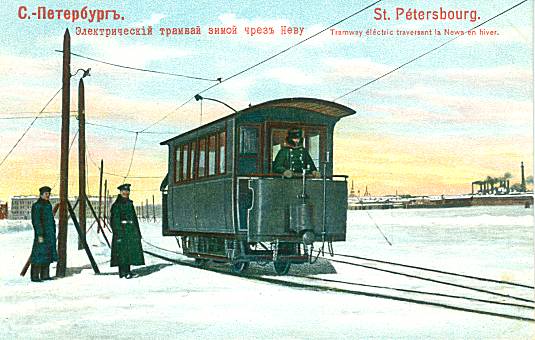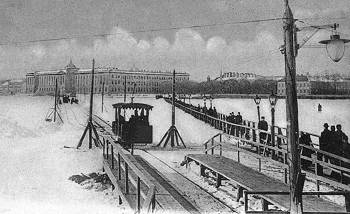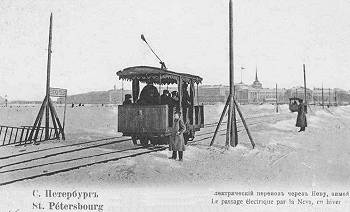

There can be few tramways that were stranger that the ice tramways built in Russia. These could only operate, indeed actually exist, for a few months each year. Their very life depended on the extremely cold Russian winters when wide rivers would freeze over, preventing any boats from operating. Probably the most famous of the ice tramways was that in St Petersburg. Our postcard of about 1905, published by W. Pfister of St. Petersburg, shows this tramway. The card captions are in Russian and French. The small postcard views below, from uncertain publishers, show one terminus and open sided trams.
The Neva River runs through the centre of the city and in the 1890s it had few bridges. There was a thriving ferry boat service to take people across the river. However, this had to cease in the winter months when the river iced over. Wooden walkways were constructed over the ice to give folk a firm footing to walk across the ice.
 In 1894 a tramway company decided to lay a temporary tramway over the ice using electric tramcars. There was an extensive horse tramway system in the city and the horse tramway operator objected to the electric tramway as they had an authorised monopoly to operate tramways on the streets of the city. The case went to court and the judge determined that the monopoly only existed for street tramways and that the river was not a street and so the ice tramway could continue to operate. The first line ran from Senate Square to the Imperial Academy of Arts on Vasilyevsky Island. It had a double track except for the stub terminals that were single track.
In 1894 a tramway company decided to lay a temporary tramway over the ice using electric tramcars. There was an extensive horse tramway system in the city and the horse tramway operator objected to the electric tramway as they had an authorised monopoly to operate tramways on the streets of the city. The case went to court and the judge determined that the monopoly only existed for street tramways and that the river was not a street and so the ice tramway could continue to operate. The first line ran from Senate Square to the Imperial Academy of Arts on Vasilyevsky Island. It had a double track except for the stub terminals that were single track.
The track was assembled on the ice by laying sleepers and fixing the flat bottom railway rails in place. As the tramway was on its own right of way, without road traffic, there was no need for grooved rail. The points were made to the standard railway design. The overhead traction poles were made of wood and set into holes drilled in the ice then held in place by pouring water into the gaps. The water would freeze, securing the pole in place. Additional stability was given by adding four struts at the base. The overhead wire was powered at 225 volts
 With a fare of just 3 Kopeks it proved extremely popular. Other than photographs, there is little information about the tramcars used. It appears that the tramway had about four trams in use. All were single deck four wheel cars with trolley poles. Some had enclosed saloons but were unvestibuled, leaving the driver to face the bitter cold in the open. Unusually there were also open crossbench tramcars (left) much more suited to warm summer days. It is possible that the tramway company hired the trams for the few months of operation and open cars would have been both available and probably cheap. The tramcars were converted from former horse cars and each carried 20 passengers. They had a maximum speed of 12 mph
With a fare of just 3 Kopeks it proved extremely popular. Other than photographs, there is little information about the tramcars used. It appears that the tramway had about four trams in use. All were single deck four wheel cars with trolley poles. Some had enclosed saloons but were unvestibuled, leaving the driver to face the bitter cold in the open. Unusually there were also open crossbench tramcars (left) much more suited to warm summer days. It is possible that the tramway company hired the trams for the few months of operation and open cars would have been both available and probably cheap. The tramcars were converted from former horse cars and each carried 20 passengers. They had a maximum speed of 12 mph
The popularity of the tramway encouraged the operators to open three other ice tramways, from the Palace Embankment to the Tax Embankment; from Suvorov Square to the Vyborg Side; and from Suvorov Square to the Petersburg Side. These tramways were single track with passing loops and they had gauges of either 1000 mm (3ft 3in) or 1067mm (3ft 6in) with a total length of all the tramways of 3.3 km. The St Petersburg ice tramways operated from 20th January to 21st March from 1895 to 1910, carrying nearly a million passengers each season. It is not clear why the service ceased, however the horse tramway system in the city started to be converted to electric operation in 1907. It may also be that climatic changes reduced the reliability of sufficiently thick ice.
Ice tramways also existed in Nizhny Novgorod from 1896 until the 1910s and in Archangel from 1917 until 1924.
(Text courtesy David Voice and Tramfare)
![]() Go to Postcard Of The Month Index
Go to Postcard Of The Month Index